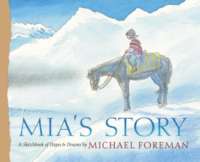
Mia’s Story: A Sketchbook of Hopes & Dreams
Written & Illustrated by Michael Foreman
Candlewick Press, 2006, 32 pp., ISBN-13: 978-0-7636-3063-8
“I will never forget the day I met Mia.” So begins this contemporary realistic fiction picture book based on Michael Foreman’s travels in Chile. Mia lives with her parents in Campamento San Francisco, a trash dump in the Andes Mountains. While she goes to school, plays, and explores their village with her friends, her father drives his truck to the city to sell scrap he’s harvested. He dreams of one day having a house of bricks to replace their home of odds and ends in the dump. One day he returns home with a puppy he found wandering the streets in the city. Mia names him Poco and the two become fast friends. When Poco disappears one winter day, Mia rides Sancho, her horse, all over the village and high into the mountains to look for him. She doesn’t find Poco but does find beautiful wildflowers in the natural beauty of the mountains. Mia brings flowers home, plants them, and under her care, the flowers grow and spread throughout the village. Even the splendor of the flowers don’t ease her memory and longing for Poco, though. One spring day, Mia convinces her father to take her along to the city so she can sell some of the flowers that came “from the stars.” Mia’s flowers are so popular with the customers that her father eventually stops selling scrap to help Mia each day and their dream of building a house of bricks grows closer to reality. Then, one day, a dog veers away from the pack running through the streets, races over to Mia, and licks her face.
This compelling story offers rich possibilities for discussions on the strength of human spirit. It is told with a respect that honors the dreams of people facing difficult life challenges. Mia, the main character, is portrayed as an intelligent, imaginative, caring, courageous female who demonstrates strength, resourcefulness and resilience in the face of numerous adversities and brings hope to her family.
The illustrations are captivating and effective. Integrated with the story narrative and watercolor landscapes are handwritten captioned sketches on scraps of paper or on travel journal pages. These add authenticity to the writing as well as provide rich information and deeper peeks into Mia’s world. Foreman adds to the authenticity by providing a glimpse of contemporary Chile, with Mia and the market vendors dressed in hats and ponchos and her father in jeans and a baseball cap. The story begins with the cover, showing Mia and Sancho high in the clean air of the pristine mountains overlooking the valley with a dark cloud hovering above the city. The front endpapers depict the desolate browns and grays that initially surround Mia’s village while the back endpapers show that view with the ground covered with “flowers as white as the mountain snow.” Foreman’s dedication to Manuel and his family, who he met in that village, is found on the last page. It reads, “May you have a house of bricks one day.”
In a text set focused on families working together for a common goal, this book would work well with A Castle on Viola Street (DiSalvo, 2001), the story of a family that dreams and works together to move from their tiny apartment into a home of their own. With a dream of going to school, Babu’s Song (Stuve-Bodeen, 2003) and Beatrice’s Goat (McBrier, 2001) describe children selling wares in the market and eventually earning enough to attend school.
Prisca Martens, Towson University, Towson, Maryland
WOW Review, Volume I, Issue 1 by Worlds of Words is licensed under a Creative Commons Attribution-NonCommercial-ShareAlike 4.0 International License. Based on work at https://wowlit.org/on-line-publications/review/i-1/
